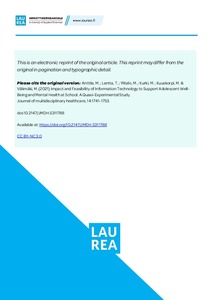Impact and Feasibility of Information Technology to Support Adolescent Well-Being and Mental Health at School: A Quasi-Experimental Study
Anttila, Minna; Lantta, Tella; Ylitalo, Milla; Kurki, Marjo; Kuuskorpi, Marko; Välimäki, Maritta (2021)
Anttila, Minna
Lantta, Tella
Ylitalo, Milla
Kurki, Marjo
Kuuskorpi, Marko
Välimäki, Maritta
Dove Medical Press
2021
Julkaisun pysyvä osoite on
https://urn.fi/URN:NBN:fi-fe2021081042730
https://urn.fi/URN:NBN:fi-fe2021081042730
Tiivistelmä
Purpose: Health-related behaviors that arise during adolescence can have important, some-times lifelong, implications on a person’s health. Psychiatric and neurodevelopmental diag-noses among minors have increased, and the related depressive symptoms may negatively affect quality of life. There is great potential for information technology (IT) to benefit the area of mental health for adolescents, and schools can serve as a setting in which this can be done. We tested whether the IT-based program “DepisNet” could be used as a universal school-based program to support adolescents’ well-being and mental health.Patients and Methods: We used a quasi-experimental, pre-post design with two preference arms (intervention and control groups). The study setting comprised two lower secondary schools (N=151 adolescents) in one city in Finland. To analyze the impact of the program, we compared the changes in the outcome measures between the two groups using T-tests and Mann–Whitney U-tests. We analyzed the changes within the groups using T-tests and Wilcoxon tests.Results: Our analysis revealed no statistically significant differences between the groups in any of the outcomes (depression, quality of life, self-esteem, self-efficacy). Regarding adolescents’ quality of life, the observed change was more positive in the intervention group, compared to that of the control group (change mean 1.36 vs −0.49), although statistical significance was not achieved (p=0.10). Our results indicated encouraging results related to the feasibility components: adherence and acceptance.Conclusion: Universal interventions and programs that relate to adolescent well-being and mental health can be integrated into school curricula to promote the awareness of adoles-cents’ general well-being and mental health issues.
